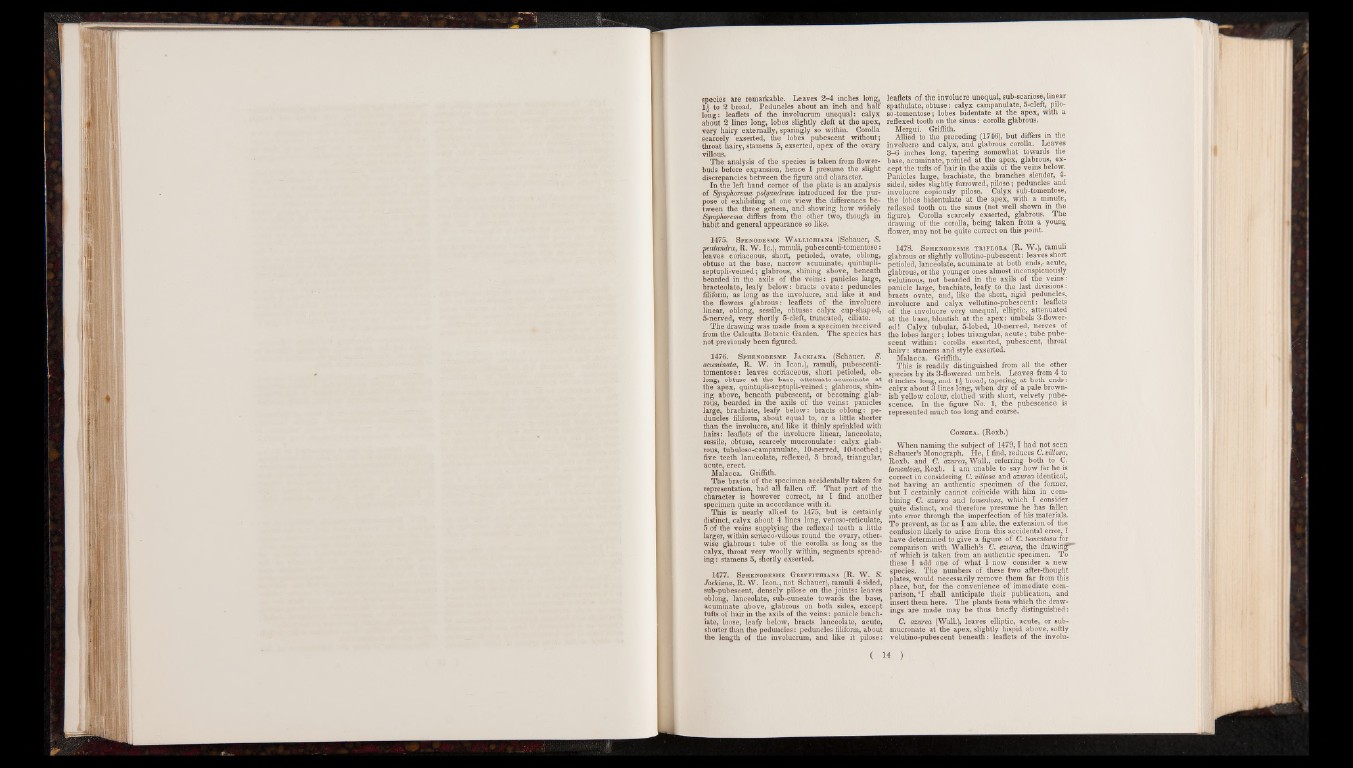
species, are remarkable. Leaves 2 -4 inches long,
l i to 2 broad. Peduncles about an inch and half
long: leaflets o f the involucrum unequal: calyx
about 2 lines long, lobes slightly cleft at the apex,
very hairy externally, sparingly so within. Corolla
scarcely exserted, the lobes pubescent without;
throat hairy, stamens 5, exserted, apex of the ovary
villous.
The analysis of the species is taken from flower-
buds before expansion, hence I presume the slight
discrepancies between the figure and character.
In the left hand corner o f the plate is an analysis
of Symphorema polyandrum introduced for the purpose
of exhibiting at one view the differences between
the three genera, and showing how widely
Symphorema differs from the other two, though in
habit and general appearance so like.
1475. Spenodesme Wallichiana (Schauer, S.
pentandra, R. W. Ic.), ramuli, pubescenti-tomentose:
leaves coriaceous, short, petioled, ovate, oblong,
obtuse at the base, narrow acuminate, quintupli-
septupli-veined; glabrous, shining above, beneath
bearded in the axils of the veins: panicles large,
bracteolate, leafy below: bracts ovate: peduncles
filiform, as long as the involucre, and like it and
the flowers glabrous: leaflets of the involucre
linear, oblong, sessile, obtuse: calyx cup-shaped,
5-nerved, very shortly 5-cleft, truncated, ciliate.
The drawing was made from a specimen received
from the Calcutta Botanic Garden. The species has
not previously been figured.
1476. S phenodesme Jackiana (Schauer. S.
acuminata, R. W. in Icon.), ramuli, pubescenti-
tomentose: leaves coriaceous, short petioled, oblong,
obtuse at the base, attenuato-acuminate at
the apex, quintupli-septupli-veined; glabrous, shining
above, beneath pubescent, or becoming glabrous,
bearded in the axils of the veins: panicles
large, brachiate, leafy below: bracts oblong: peduncles
filiform, about equal to, or a little shorter
than the involucre, and like it thinly sprinkled with
hairs: leaflets of the involucre linear, lanceolate,
sessile, obtuse, scarcely mucronulate: calyx glabrous,
tubuloso-campanulate, 10-nerved, 10-toothed;
five teeth lanceolate, reflexed, 5 broad, triangular,
acute, erect.
Malacca. Griffith.
The bracts of the specimen accidentally taken for
representation, had all fallen off. That part of the
character is however correct, as I find another
specimen quite in accordance with it.
This is nearly allied to 1475, but is certainly
distinct, calyx about 4 lines long, venoso-reticulate,
5 of the veins supplying the reflexed teeth a little
larger, within serieco-villous round the ovary, otherwise
glabrous: tube of the corolla as long as the
calyx, throat very woolly within, segments spreading
: stamens 5, shortly exserted.
1477. S phenodesme Grippithiana (R. W. &
Jackiana, R. W. Icon., not Schauer), ramuli 4-sided,
sub-pubescent, densely pilose on the joints: leaves
oblong, lanceolate, sub-cuneate towards the base,
acuminate above, glabrous on both sides, except
tufts of hair in the axils of the veins: panicle brachiate,
loose, leafy below, bracts lanceolate, acute,
shorter than the peduncles: peduncles filiform, about
the length of the involucrum, and like it pilose:
leaflets of the involucre unequal, sub-scariose, linear
spathulate, obtuse: calyx campanulate, 5-cleft, pilo-
so-tomentose; lobes bidentate at the apex, with a
reflexed tooth on the sinus: corolla glabrous.
Mergui. Griffith.
Allied to the preceding (1746), but differs in the
involucre and calyx, and glabrous corolla. Leaves
3 -6 inches long, tapering somewhat towards the
base, acuminate, pointed at the apex, glabrous, except
the tufts of hair in the axils of the veins below.
Panicles large, brachiate, the branches slender, 4-
sided, sides slightly furrowed, pilose; peduncles and
involucre copiously pilose. Calyx sub-tomentose,
the lobes bidentulate at the apex, with a minute,
reflexed tooth on the sinus (not well shown in the
figure). Corolla scarcely exserted, glabrous. The
drawing of the corolla, being taken from a young
flower, may not be quite correct on this point.
1478. S phenodesme triflora (R. W.), ramuli
glabrous or slightly vellutino-pubescent: leaves short
petioled, lanceolate, acuminate at both ends*- acute,
glabrous, or the younger ones almost inconspicuously
velutinous, not bearded in the axils of the veins:
panicle large, brachiate, leafy to the last divisions:
bracts ovate, and, like the short, rigid peduncles,
involucre and calyx vellutino-pubescent: leaflets
of the involucre very unequal, elliptic, attenuated
at the base, bluntish at the apex: umbels 3-flower-
ed! Calyx tubular, 5-lobed, 10-nerved, nerves of
the lobes larger; lobes triangular, acute; tube pubescent
within: corolla exserted, pubescent, throat
hairy: stamens and style exserted.
Malacca. Griffith.
This is readily distinguished from all the other
species by its 3-flowered umbels. Leaves from 4 to
6 inches long, and 1^ broad, tapering at froth ends:
calyx about3 lines long, when dry of a pale brownish
yellow colour, clothed with short, velvety pubescence.
In the figure No. 1, the pubescence is
represented much too long and coarse.
Congea. (Roxb.)
When naming the subject of 1479,1 had not seen
Schauer’s Monograph. He, I find, reduces C. villosa,
Roxb. and C. azurea, Wall., referring both to C.
tomentosa, Roxb. I am unable to say how far he is
correct in considering C. villosa and azurea identical,
not having an authentic specimen of the former,
but I certainly cannot coincide with him in combining
C. azurea and tomentosa, which I consider
quite distinct, and therefore presume he has fallen
into error through the imperfection of his materials.
To prevent, as far as I am able, the extension of the
confusion likely to arise from this accidental error, I
have determined to give a figure of C. tomentosa for
comparison with Wallich’s C. azurea, the drawing""
of which is taken from an authentic specimen. To
these I add one of what I now consider a new
species. The numbers of these two after-thought
plates, would necessarily remove them far from this
place, but, for the convenience of immediate comparison,
'1 shall anticipate their publication, and
insert them here. The plants from which the drawings
are made may be thus briefly distinguished:
C. azurea (Wall.), leaves elliptic, acute, or sub-
mucronate at the apex, slightly hispid above, softly
velutino-pubescent beneath: leaflets of the involu